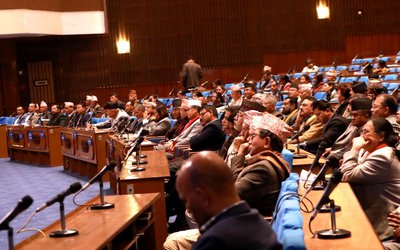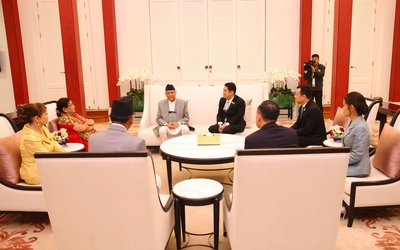As a world class highway network expands all over India, Nepal is getting connected to it through border points, like the busiest Raxaul of Bihar or Sunauli of Uttar Pradesh. India’s highways are smooth and fast, at 80 km an hour.
The upgrading and expansion of the highway networks have sped up development activities in the Indian states. The cost of transportation is coming down. It could mean enormous opportunities even for the Nepalese goods in India, although there remain several other challenges.
India’s economy growing by over 9 per cent annually will have global implications. As a close neighbor, Nepal can tap any opportunity opened up by this robust growth. Nepalese economists argue that Nepal can make economic gains from the growth of the southern neighbor, with which Nepal has cultural, religious and other similarities.
This scribe had a chance to see the changes occurring fast, far and wide when he travelled 15 states of north and south India, including Nepal’s neighboring states. Economic changes are visible in production, agriculture and infrastructure sectors. With the expansion of irrigation system, the agriculture sector has also made a major progress, transforming its traditional, rural economy into a modern one.
The railways and freight services in major ports have also improved a lot.
“The size of Indian economy means that what happens in India over the coming decades has important implications for global growth, inequality and poverty,” said Mark Rosenzweig, Professor of International Economics, at Yale University, commenting on a book Sustaining India’s Growth Miracle.
Arvind Panagariya, Professor of Indian political economy in the Department of International and Public Affairs at Columbia University, argues that India’s high economic growth will make a dramatic change in the world.
Edited by Jagadish N. Bhagawati, professor at Columbia University and Charles W.Calomiris, Professor of financial institutions at Columbia University, the newly published book Sustaining India’s Growth Miracle revealed how India’s high economic growth will affect the global economy.
As a close neighbor sharing many things, including the topography with south facing lands, Nepal will be the first country to feel the heat in the region. However, Nepal’s political leadership is yet to develop a vision in view of the changes happening in the south. Instead of coming up with ways to boost trade, Nepalese leaders are stuck up in useless debates with India. Worse, Nepal has been passing though a lingering political instability.
“The time has come for Nepal’s political leadership to realize the importance of Nepal’s connectivity with India and chalk the way to get benefits,” said an economist.
Led by Communist Party of Nepal (Unified Marxist and Leninist) chairman Jhalnath Khanal, the present coalition with UCPN-Maoist has yet to produce any concrete plan to benefit from this growth. Instead, UCPN-Maoist party leaders are harping on anti-Indian statements- which will certainly have long-term implications for Nepal.
From boulders to sand and other agriculture products like vegetables, and fish, Nepal can increase its supply. Similarly, Nepal can also benefit from increasing export of hydro power. Similarly, Nepal can attract a large number of Indian tourists from road as well as air.
Despite such huge potentials in tapping into India’s growth, Nepal’s political parties are yet to make any strategy in the changing circumstances.
“It is unfortunate that Nepalese political leaders have no vision at all to get benefits from India’s progress. Instead of making any strategy, political parties are harping on anti-Indian slogans in the street. This is neither in the interest of people nor in the interest of country,” an observer said.
With load shedding of up to 14 hours a day; Nepal’s overall economic scenario is going from bad to worse. The crisis of Nepal’s hydro-electricity can be lessened by the southern neighbor.
Impacts of Indian Economy
Whether the political leadership takes it or not, India’s economic progress is gradually integrating Nepal’s economy. Even the Indian budget is having effects on Nepal’s economy.
Indian Finance Minister Mukherjee began his Budget speech for 2011-12, stating that the average inflation will be down next year and that Indian economy is expected to grow at 9% annually. The agriculture sector has recorded a growth of 5.4% while industry has grown by 8.1% in 2010-11. He added that the current account deficit poses a major concern. The major highlights of the budget, inter, alia, are: encouraging trends in development of external sector ; taxes, tariff procedures will be simplified; to reconcile environment concerns, growth needs; current account deficit poses a concern ; 13th Finance Commission has worked out fiscal consolidation roadmap; agriculture growth at 5.4%, industry at 8.1% in 2010-11; self-sufficiency in pulses, Rs 300 crore allocated for 60,000 pulses villages to increase production and productivity; self-help group fund to empower women ; task force working on oil subsidy plans; Rs 600 crore to public sector banks to maintain mandatory CRR; liberalization of FDI policy; FII allowed to invest in MF schemes; 15 more mega food parks to be promoted. This is what Shanker Man Singh writes in his article.
“The latest Indian budget has uncovered Nepal to challenges and opportunities, something which has left the government reeling under the pressure of high inflation and historic high balance of payments deficit. Moreover, the Indian budget has risen public spending, subsidized on petroleum products that are acknowledged to decrease inflation in India – signaling a strong impact in Nepal as well. Since the Nepali financial authorities are already facing hard times to contain the double-digit inflation, the possible repercussions of the Indian budget might be a woe for the Nepal Rastra Bank (NRB),” said economist Shanker Man Singh. “The Indian budget will raise the price of gold, silver, air fare, cigarettes, and fridge. With the increase in the prices of gold in India, smuggling may be curtailed in trade with Nepal. This will also have an effect on Nepal’s import tariff regime and the control of unauthorized trade.”
Bilateral Activities
With a functional democracy, India has proved that the development and high growth are possible in a democratic society. “Today what we have done is proven that democracy and development, federal democracy and development, with devolution, are inseparable,” said Ronen Sen, Indian ambassador to the United States.
Addressing the inaugural function of a seminar on `India-Nepal Relations' organized in Benaras by the Ministry of External Affair, the governor of Uttar Pradesh said that India and Nepal share a unique and special relationship rooted in shared history, geography, culture, language and civilization.
“India would construct 19 roads exceeding 600 km in the Terai region of Nepal; establish two integrated check-posts and two cross-border railway links over the next two-three years in the first phase. In the second phase, India would construct additional 800 km roads, three cross-border railway links and two integrated check-posts. Six of the roads in phase-I, two of the integrated check-posts in phase-II and two of the rail links in phase-II would be built along the India-Nepal border in Uttar Pradesh,” added the governor.
The first round of Nepal-India Inter Governmental Sub Committee (IGSC) meeting took place in New Delhi. Joint secretaries of the two countries held a meeting last week, said Kailash Bajimaya, under secretary at the Ministry of Commerce and Supplies (MoCS).
MoCS has been preparing for the meeting since early January and held discussions with the private sector
In the new trade treaty, India has agreed to open new trade routes for Nepal including new air routes, opening up of Vishakhapatnam port as an additional transit port for Nepal, along with allowing the use of Rohanpur-Singhabad rail route for Nepal-Bangladesh trade.
As India’s economy is growing fast, the time has come for Nepalese leaders to work on how to gain from it. Instead of politicization of relations, a realistic trade approach would go a long way towards taking those benefits.
Like it or not, Nepal’s overall economic development will depend on how quickly it integrates its economy with that of India.
Bilateral Activities
With a functional democracy, India has proved that the development and high growth are possible in a democratic society. “Today what we have done is proven that democracy and development, federal democracy and development, with devolution, are inseparable,” said Ronen Sen, Indian ambassador to the United States.
Addressing the inaugural function of a seminar on `India-Nepal Relations' organized in Benaras by the Ministry of External Affair, the governor of Uttar Pradesh said that India and Nepal share a unique and special relationship rooted in shared history, geography, culture, language and civilization.
“India would construct 19 roads exceeding 600 km in the Terai region of Nepal; establish two integrated check-posts and two cross-border railway links over the next two-three years in the first phase. In the second phase, India would construct additional 800 km roads, three cross-border railway links and two integrated check-posts. Six of the roads in phase-I, two of the integrated check-posts in phase-II and two of the rail links in phase-II would be built along the India-Nepal border in Uttar Pradesh,” added the governor.
The first round of Nepal-India Inter Governmental Sub Committee (IGSC) meeting took place in New Delhi. Joint secretaries of the two countries held a meeting last week, said Kailash Bajimaya, under secretary at the Ministry of Commerce and Supplies (MoCS).
MoCS has been preparing for the meeting since early January and held discussions with the private sector
In the new trade treaty, India has agreed to open new trade routes for Nepal including new air routes, opening up of Vishakhapatnam port as an additional transit port for Nepal, along with allowing the use of Rohanpur-Singhabad rail route for Nepal-Bangladesh trade.
As India’s economy is growing fast, the time has come for Nepalese leaders to work on how to gain from it. Instead of politicization of relations, a realistic trade approach would go a long way towards taking those benefits.
Like it or not, Nepal’s overall economic development will depend on how quickly it integrates its economy with that of India.











